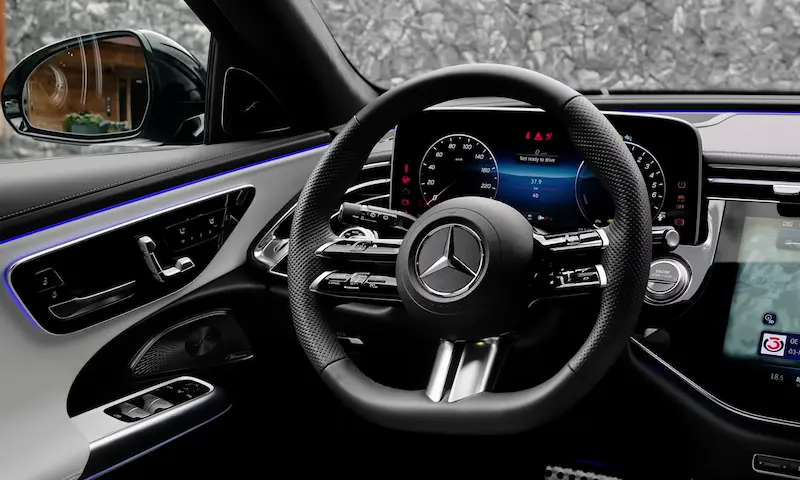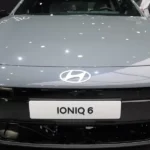Having your Mercedes Benz warn you that the “Blind Spot Assist Inoperative” is like losing an extra set of eyes on the road. This critical safety feature helps protect you from one of driving’s most dangerous scenarios, but when it fails, you’re suddenly vulnerable again.
Let’s dive into why this happens, how to diagnose it, and most importantly, how to get this essential safety system back up and running.
How Mercedes Benz Blind Spot Assist Actually Works
The Technology Behind Your Safety
Mercedes Benz Blind Spot Assist uses radar sensors mounted in your rear bumper that constantly scan the areas you can’t easily see. These sensors monitor adjacent lanes up to 10 meters behind your vehicle, creating a safety zone around your car. When they detect another vehicle entering your blind spot, a red triangle illuminates in your side mirror. If you signal to change lanes while something’s there, the system flashes the warning and sounds an alert to prevent a potential collision.
The system activates automatically once you’re traveling above 20 mph (30 km/h) and works in coordination with your car’s other safety systems through the Controller Area Network (CAN).
Integration With Mercedes Safety Suite
Your Blind Spot Assist doesn’t work alone. It’s part of Mercedes’ comprehensive safety ecosystem that includes Active Brake Assist and Lane Keeping Assist. This integration means if you attempt a lane change despite warnings, other systems may intervene to help prevent a collision. This complex network requires seamless communication between multiple sensors and your car’s Electronic Stability Program (ESP).
Why Your Mercedes Blind Spot Assist Stops Working
Sensor Obstruction: The Most Common Culprit
The most frequent reason for Blind Spot Assist failure is surprisingly simple: dirt, snow, ice, or road grime covering your sensors. Since these radar units are positioned in the rear bumper, they’re constantly exposed to road debris and weather elements.
Many Mercedes owners have reported that simply cleaning mud and debris from around the bumper corners restored functionality. This is especially common during winter months when slush and salt build up quickly.
Sensor Misalignment Issues
According to Mercedes-Benz technical bulletins, about 40% of persistent Blind Spot Assist failures stem from sensor misalignment. Even minor bumper impacts can shift the precise angle of your sensors, causing incorrect readings.
For example, misaligned sensors often trigger specific fault codes like C375300 (left sensor misadjusted) and C375200 (right sensor misadjusted). These issues typically require professional correction through bracket modification and recalibration.
Electrical and Software Glitches
Even luxury vehicles aren’t immune to electrical gremlins. Low battery voltage—particularly during cold-weather startups—can corrupt sensor configurations. If voltage drops below 11.5 volts during engine start, it can disrupt communication between sensors and your ESP module.
Software glitches account for roughly 25% of cases. Your Mercedes might be running outdated firmware, which can lead to configuration errors. A 2017 Mercedes service bulletin specifically addresses this by recommending radar sensor updates to version 17/30 00.
Physical Damage and Water Problems
Your radar sensors are vulnerable to physical damage. Road debris, parking mishaps, or even aggressive car washes can crack sensor housings or damage internal components.
Water infiltration presents another common issue. After car washes or heavy rain, moisture can seep into sensor connectors, corroding terminals and interrupting signals. This often requires professional attention to replace damaged connectors or even entire sensor units.
How to Diagnose Blind Spot Assist Problems
Quick Checks You Can Do Yourself
Before heading to the dealership, try these preliminary checks:
- Visual inspection: Examine your rear bumper for obvious dirt, damage, or misaligned sensors. Clean the sensor areas with mild soap and a soft cloth.
- System reset: Sometimes the solution is as simple as a reset. Turn off your ignition completely for about 15 minutes, allowing the CAN network to reset. Then reactivate the Blind Spot Assist through your instrument cluster settings menu.
- Check for obstructions: Look for anything that might block the sensors’ view, including bumper stickers, aftermarket accessories, or trailer hitches.
Professional Diagnostics With Specialized Tools
For persistent issues, professional diagnostics using Mercedes’ XENTRY tool becomes necessary:
- Fault code analysis: Specific codes like C110178 (radar sensor malfunction) or U150487 (communication failure) help technicians pinpoint exactly which component is failing.
- Live data readings: Technicians can monitor radar signal strength and alignment angles in real-time. Deviations beyond ±2 degrees indicate misalignment requiring correction.
- Electrical testing: A proper diagnosis includes voltage testing at the sensor connectors. Readings below 11V during engine start suggest power supply problems.
Calibration Requirements
After any physical repairs, your sensors will need professional recalibration:
- Static calibration: This requires positioning your vehicle on a perfectly flat surface with calibration targets placed 2 meters behind each bumper. Specialized equipment then aligns the sensors to factory specifications.
- Dynamic calibration: Following static alignment, you’ll need a driving calibration. This involves driving at 40–60 mph for approximately 10 minutes on straight roads, allowing the system to fine-tune based on actual driving conditions.
Fixing Your Mercedes Benz Blind Spot Assist
DIY Maintenance Solutions
For minor issues, these maintenance steps may restore functionality:
- Regular cleaning: Use pH-neutral cleaners to gently remove dirt from sensor areas. Avoid abrasive materials that might scratch the bumper or sensors.
- Apply protective treatment: A light application of silicone spray to sensor seals can repel water and reduce corrosion risk, especially in wet climates.
- Battery maintenance: Since low voltage can trigger failures, ensure your battery is in good condition, particularly before winter weather arrives.
| Maintenance Task | Frequency | Benefits |
|---|---|---|
| Sensor cleaning | Monthly (more in winter) | Prevents false alerts and system deactivation |
| Battery check | Quarterly | Ensures stable power to sensors |
| Seal inspection | Bi-annually | Prevents water infiltration |
| Bumper inspection | After impacts or car washes | Identifies potential misalignment early |
Professional Repairs
For more serious issues, professional intervention is necessary:
Bracket Modification for Misaligned Sensors
Mercedes Technical Service Bulletin LI54.71-P-072473 outlines a specific procedure for correcting sensor misalignment:
- The rear bumper and sensor covers are removed.
- The sensor is detached, the bracket is modified to allow proper positioning, and it’s reinstalled with foam pads for stability.
- Technicians then recalibrate using XENTRY and validate with a test drive.
Electrical Repairs
When wiring issues are found:
- Damaged wiring harnesses are repaired with heat-shrink tubing and dielectric grease.
- Ground points G3/3 (left rear) and G3/4 (right rear) are cleaned to ensure proper electrical connections.
- Corroded connectors are replaced to restore reliable communication.
Software Updates
Software issues require:
- Installing the latest firmware via Mercedes’ XENTRY diagnostic system.
- Recoding radar sensors using Software Calibration Numbers (SCN) to synchronize with your vehicle’s specific VIN.
- Testing to ensure proper integration with other safety systems.
Preventive Measures to Keep Your System Working
Regular Maintenance Schedule
Establish these habits to minimize Blind Spot Assist failures:
- Monthly: Clean sensors and inspect for visible damage.
- Every Two Years: Have software updates performed at authorized service centers.
- After Any Collision: Get sensors recalibrated even after seemingly minor bumper impacts.
Adapting to Your Environment
If you live in harsh climates:
- Snowy regions: Consider installing protective grilles over sensor areas.
- Car washes: Avoid directing high-pressure spray directly at rear bumper sensors.
- Coastal areas: Apply extra protection against salt corrosion on sensor connections.
Understanding Warning Signs
Pay attention to these early warning signs:
- Intermittent Blind Spot Assist failures that come and go
- False alerts when no vehicle is present
- Delayed warnings when vehicles enter your blind spot
- System deactivations during rainy or snowy conditions
The Technology’s Limitations and Future
Current Limitations
It’s important to understand the system’s boundaries:
- Radar sensors can struggle in heavy rain or snow.
- Small objects like motorcycles might be detected later than larger vehicles.
- The system doesn’t replace proper mirror checks and driver awareness.
- Very slow-moving vehicles (below 20 mph) might not trigger the system.
Expected Improvements
Mercedes continues evolving this technology:
- Newer models feature more water-resistant sensor designs.
- Updated algorithms improve detection in adverse weather.
- Integration with camera systems provides redundancy when radar is compromised.
- Self-diagnostic capabilities alert you earlier when maintenance is needed.
Cost Considerations for Repairs
DIY vs. Professional Service
While cleaning sensors yourself costs nearly nothing, professional repairs vary significantly:
- Sensor cleaning and reset: $0-150 (DIY to basic service)
- Software updates: $150-300 (dealer service)
- Sensor recalibration: $200-400 (requires specialized equipment)
- Sensor replacement: $500-1,200 per sensor (parts and labor)
- Wiring repairs: $200-600 (depending on complexity)
This wide cost range makes proper diagnosis crucial before authorizing expensive repairs.
Insurance Considerations
If your Blind Spot Assist failure resulted from a collision:
- Document the connection between the accident and system failure.
- Check if your comprehensive coverage includes electronic system repairs.
- Consider whether filing a claim makes financial sense given your deductible.
Impact on Vehicle Safety and Resale
Safety Implications
A non-functioning Blind Spot Assist significantly impacts safety:
- You lose crucial warnings about vehicles in adjacent lanes.
- The integration with other safety systems may be compromised.
- Your risk of side-swipe collisions increases, especially during lane changes.
- NHTSA data suggests blind spot monitoring systems reduce injury crashes by up to 23%.
Resale Value Factors
When selling your Mercedes:
- Functional safety systems significantly impact resale value.
- Pre-sale inspections typically check all electronic safety features.
- Documented maintenance and repairs of safety systems reassure potential buyers.
- Certified pre-owned programs require all safety systems to be fully operational.
What Makes Mercedes Benz Blind Spot Assist Different
Comparison with Other Manufacturers
The Mercedes system offers several distinctions:
- Earlier activation speed (20 mph vs. 25-30 mph in many competitors)
- Integration with steering and braking systems for active intervention
- Enhanced exit warning that operates even after parking
- Premium radar components with typically longer service life
| Manufacturer | Activation Speed | Warning Method | Active Intervention |
|---|---|---|---|
| Mercedes-Benz | 20 mph | Mirror icon + audio | Yes (steering/braking) |
| BMW | 25 mph | Mirror icon | Limited |
| Audi | 20 mph | Mirror icon + audio | Yes |
| Lexus | 25 mph | Mirror icon | Limited |
Mercedes-Specific Technologies
Mercedes enhances its system with:
- Exit warning functionality that operates even after parking
- Radar-based detection rather than camera-only systems used by some competitors
- Integrated calibration with other driver assistance features
- Extended range (up to 10 meters vs. 5-7 meters in many competitors)
By maintaining this sophisticated safety system, you’re not just protecting your investment in a premium vehicle – you’re ensuring that one of its most important safety features remains on duty, watching those blind spots that even the most attentive drivers can miss.












